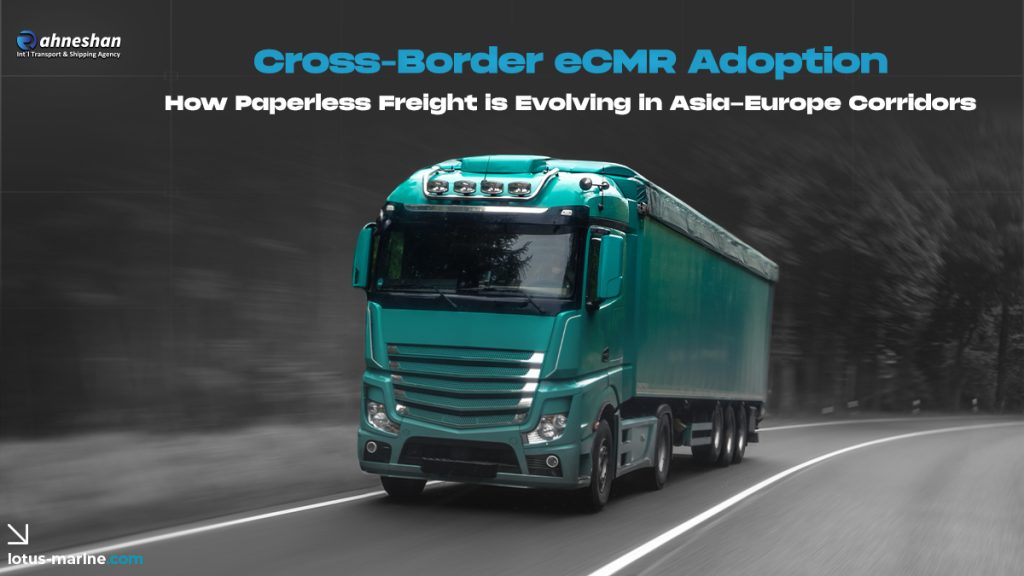Introduction
The logistics industry is entering a new digital era, driven by the need for faster, more transparent, and sustainable cross-border operations. A major milestone in this transformation is the adoption of the electronic Consignment Note (eCMR) — the digital alternative to traditional paper-based CMR documents. In 2025, eCMR adoption is accelerating along Asia–Europe freight corridors, improving operational efficiency, reducing costs, and enhancing data accuracy in international road transport.
What Is eCMR?
The eCMR (electronic Consignment Note) is a digital version of the CMR document used for road freight transport under the CMR Convention. It provides legally recognized evidence of cargo transport details — such as shipper, carrier, consignee, and cargo description — but in a secure, paperless format.
Why eCMR Matters for Asia–Europe Trade
1. Operational Efficiency
Replacing paper with digital documentation streamlines customs processing, reduces human errors, and speeds up border crossings.
2. Transparency and Traceability
eCMR platforms allow all stakeholders — from carriers to customs authorities — to access shipment data in real time, reducing disputes and fraud.
3. Sustainability
Paperless systems cut administrative waste and align with global ESG and carbon reduction goals.
4. Integration with Digital Trade Corridors
eCMR fits into broader initiatives such as Digital Silk Road and EU’s Digital Transport and Logistics Forum (DTLF), creating standardized cross-border workflows.
Current Status of eCMR Adoption in 2025
-
Europe: Over 25 EU and EFTA countries have ratified the eCMR Protocol, with widespread use in intra-EU transport.
-
Asia: Nations along the Belt and Road Initiative (BRI) — including Kazakhstan, Uzbekistan, and China — are expanding eCMR pilots for westbound exports.
-
Cross-Border Corridors: Multimodal operators connecting Central Asia, the Middle East, and Eastern Europe are integrating eCMR into customs and digital freight platforms.
Technology Enablers
-
Blockchain: Ensures document authenticity and tamper-proof record-keeping.
-
IoT Sensors: Automatically feed cargo status and location data into the eCMR system.
-
AI & OCR Tools: Enable fast data validation and error detection across multilingual routes.
-
Cloud-Based Platforms: Support secure data exchange between carriers, freight forwarders, and regulators.
Challenges in Full-Scale Implementation
-
Regulatory Misalignment: Not all Asian countries have ratified or recognized eCMR.
-
Technical Interoperability: Different systems across countries create data integration issues.
-
Training & Adoption: Smaller logistics firms lack digital readiness and resources.
-
Legal Validity: Some jurisdictions still require paper copies for dispute resolution.
Benefits for Freight Forwarders and Carriers
-
Reduced Administrative Costs by eliminating printing, archiving, and courier services.
-
Faster Customs Clearance through pre-verified electronic documentation.
-
Improved Accuracy with real-time cargo tracking and automated updates.
-
Enhanced Collaboration across multiple partners using standardized digital workflows.
Future Outlook
By 2030, the Asia–Europe corridor is expected to achieve full interoperability of eCMR systems, supported by blockchain-enabled digital trade platforms. Governments and logistics associations are also working on mutual recognition agreements (MRAs) to simplify cross-border legal acceptance. In combination with eFTI (electronic Freight Transport Information) and digital TIR systems, eCMR will become the backbone of seamless paperless freight.
Conclusion
The shift toward cross-border eCMR adoption is redefining freight transport across Asia–Europe routes. By improving transparency, reducing costs, and accelerating customs clearance, eCMR is paving the way for a more efficient and sustainable logistics ecosystem. As governments, carriers, and tech providers align their systems, paperless freight will soon be the new global standard.
Frequently Asked Questions
1. What is eCMR?
A digital version of the paper CMR document that records all contractual details of international road transport.
2. Which countries are leading in eCMR adoption?
Most EU nations, along with Kazakhstan, Turkey, and parts of China, are advancing cross-border eCMR initiatives.
3. How does eCMR improve supply chain efficiency?
It enables real-time data sharing, reduces delays, and simplifies customs procedures.
4. Is eCMR legally binding?
Yes, under the Additional Protocol to the CMR Convention (2008), eCMR has the same legal standing as paper documents.
5. What technologies support eCMR platforms?
Blockchain, IoT, AI, and secure cloud infrastructures ensure data integrity and interoperability.







